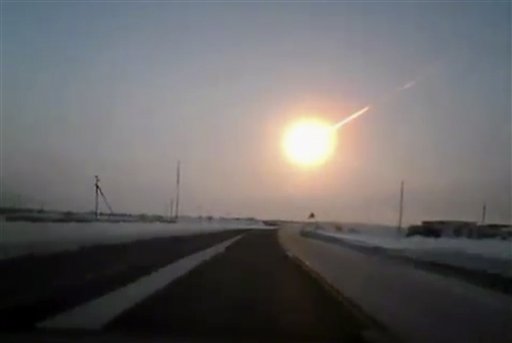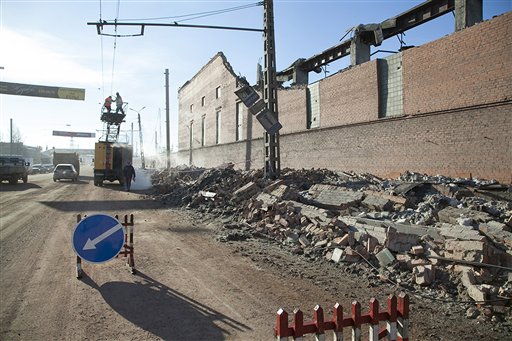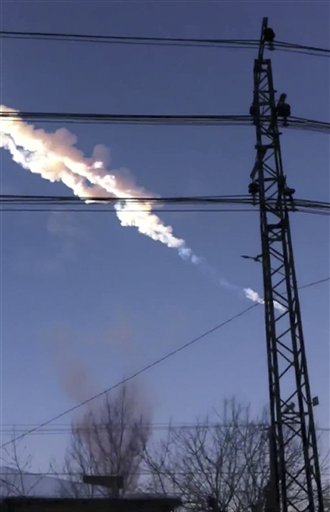MOSCOW — With a blinding flash and a booming shock wave, a meteor blazed across the western Siberian sky Friday and exploded with the force of 20 atomic bombs, injuring more than 1,000 people as it blasted out windows and spread panic in a city of 1 million.
While NASA estimated the meteor was only about the size of a bus and weighed an estimated 7,000 tons, the fireball it produced was dramatic. Video shot by startled residents of the city of Chelyabinsk showed its streaming contrails as it arced toward the horizon just after sunrise, looking like something from a world-ending science-fiction movie.
The largest recorded meteor strike in more than a century occurred hours before a 150-foot asteroid passed within about 17,000 miles (28,000 kilometers) of Earth. The European Space Agency said its experts had determined there was no connection between the asteroid and the Russian meteor — just cosmic coincidence.
The meteor above western Siberia entered the Earth’s atmosphere about 9:20 a.m. local time (10:20 p.m. EST Thursday) at a hypersonic speed of at least 33,000 mph (54,000 kph) and shattered into pieces about 30-50 kilometers (18 to 32 miles) high, the Russian Academy of Sciences said. NASA estimated its speed at about 40,000 mph, said it exploded about 12 to 15 miles high, released 300 to 500 kilotons of energy and left a trail 300 miles long.
“There was panic. People had no idea what was happening,” said Sergey Hametov of Chelyabinsk, about 1,500 kilometers (930 miles) east of Moscow in the Ural Mountains.
“We saw a big burst of light, then went outside to see what it was and we heard a really loud, thundering sound,” he told The Associated Press by telephone.
The shock wave blew in an estimated 100,000 square meters (more than 1 million square feet) of glass, according to city officials, who said 3,000 buildings in Chelyabinsk were damaged. At a zinc factory, part of the roof collapsed.
The Interior Ministry said about 1,100 people sought medical care after the shock wave and 48 were hospitalized. Most of the injuries were caused by flying glass, officials said.
Scientists estimated the meteor unleashed a force 20 times more powerful than the Hiroshima bomb, although the space rock exploded at a much higher altitude. Amy Mainzer, a scientist at NASA’s Jet Propulsion Laboratory, said the atmosphere acted as a shield.
The shock wave may have shattered windows, but “the atmosphere absorbed the vast majority of that energy,” she said.
Emergency Situations Ministry spokesman Vladimir Purgin said many of the injured were cut as they flocked to windows to see what caused the intense flash of light, which momentarily was brighter than the sun.
There was no immediate word on any deaths or anyone struck by space fragments.
President Vladimir Putin summoned the nation’s emergencies minister and ordered immediate repairs. “We need to think how to help the people and do it immediately,” he said.
Some meteorite fragments fell in a reservoir outside the town of Chebarkul, the regional Interior Ministry office said. The crash left an eight-meter (26-foot) crater in the ice.
Lessons had just started at Chelyabinsk schools when the meteor exploded, and officials said 258 children were among those injured. Amateur video showed a teacher speaking to her class as a powerful shock wave hit the room.
Yekaterina Melikhova, a high school student whose nose was bloody and whose upper lip was covered with a bandage, said she was in her geography class when a bright light flashed outside.
“After the flash, nothing happened for about three minutes. Then we rushed outdoors. … The door was made of glass, a shock wave made it hit us,” she said.
Russian television ran video of athletes at a city sports arena who were showered by shards of glass from huge windows. Some of them were still bleeding.
Other videos showed a long shard of glass slamming into the floor close to a factory worker and massive doors blown away by the shock wave.
Meteors typically cause sizeable sonic booms when they enter the atmosphere because they are traveling so much faster than the speed of sound. Injuries on the scale reported Friday, however, are extraordinarily rare.
“I went to see what that flash in the sky was about,” recalled resident Marat Lobkovsky. “And then the window glass shattered, bouncing back on me. My beard was cut open, but not deep. They patched me up. It’s OK now.”
Another resident, Valya Kazakov, said some elderly women in his neighborhood started crying out that the world was ending.
The many broken windows exposed residents to the bitter cold as temperatures in the city were expected to plummet to minus 20 Celsius (minus 4 Fahrenheit) overnight. The regional governor put out a call for any workers who knew how to repair windows.
Russian-language hashtags for the meteorite quickly shot up into Twitter’s top trends.
“Jeez, I just woke up because my bed started shaking! The whole house is moving!” tweeted Alisa Malkova.
Social media was flooded with video from the many dashboard cameras that Russians mount in their cars, in case of pressure from corrupt traffic police or a dispute after an accident.
The dramatic event prompted an array of reactions from prominent Russians.
Prime Minister Dmitry Medvedev, speaking at an economic forum in the Siberian city of Krasnoyarsk, said the meteor could be a symbol for the forum, showing that “not only the economy is vulnerable, but the whole planet.”
Vladimir Zhirinovsky, a nationalist leader noted for his vehement statements, blamed the Americans.
“It’s not meteors falling. It’s the test of a new weapon by the Americans,” the RIA Novosti news agency quoted him as saying.
Deputy Prime Minister Dmitry Rogozin said the incident showed the need for leading world powers to develop a system to intercept objects falling from space.
“At the moment, neither we nor the Americans have such technologies” to shoot down meteors or asteroids, he said, according to the Interfax news agency.
Meteoroids are small pieces of space debris — usually parts of comets or asteroids — that are on a collision course with the Earth. They become meteors when they enter the Earth’s atmosphere. Most meteors burn up in the atmosphere, but if they survive the frictional heating and strike the surface of the Earth they are called meteorites.
NASA said the Russian fireball was the largest reported since 1908, when a meteor hit Tunguska, Siberia, and flattened an estimated 80 million trees. Chelyabinsk is about 5,000 kilometers (3,000 miles) west of Tunguska. The Tunguska blast, attributed to a comet or asteroid fragment, is generally estimated to have been about 10 megatons.
Scientists believe that a far larger meteorite strike on what today is Mexico’s Yucatan Peninsula may have been responsible for the extinction of the dinosaurs about 66 million years ago. According to that theory, the impact would have thrown up vast amounts of dust that blanketed the sky for decades and altered the climate on Earth.
The object hailed from the asteroid belt between Mars and Jupiter, becoming a meteor as it streaked through the earth’s atmosphere, Bill Cooke, head of the Meteoroid Environments Office at NASA’s Marshall Space Flight Center in Huntsville, Alabama, said.
Paul Chodas, research scientist at the Near Earth Object Program Office at the Jet Propulsion Laboratory, said that ground telescopes would have needed to point in the right direction at the right time to spot Friday’s incoming meteor.
“It would be very faint and difficult to detect, not impossible, but difficult,” Chodas said.
The 150-foot space rock that safely hurtled past Earth at 2:25 p.m. EST Friday was dubbed Asteroid 2012 DA14 and was discovered a year ago. It came closer than many communication and weather satellites that orbit 22,300 miles up.
The asteroid was invisible to astronomers in the United States at the time of its closest approach on the opposite of the world. But in Australia, astronomers used binoculars and telescopes to watch the point of light speed across the clear night sky.
Jim Green, NASA’s director of planetary science, called the back-to-back celestial events an amazing display.
“This is indeed very rare and it is historic,” he said on NASA TV. “These fireballs happen about once a day or so, but we just don’t see them because many of them fall over the ocean or in remote areas. “
Experts said the Russian meteor could have produced much more serious problems in the area hosting nuclear and chemical weapons disposal facilities.
Vladimir Chuprov of Greenpeace Russia noted that the meteor struck only 100 kilometers (60 miles) from the Mayak nuclear storage and disposal facility, which holds dozens of tons of weapons-grade plutonium.
The panic and confusion that followed the meteor quickly gave way to typical Russian black humor and entrepreneurial instincts. Several people smashed in the windows of their houses in the hopes of receiving compensation, the RIA Novosti news agency reported.
Others quickly took to the Internet and put what they said were meteorite fragments up for sale.
One of the most popular jokes was that the meteorite was supposed to fall on Dec. 21, 2012 — when many believed the Mayan calendar predicted the end of the world — but was delivered late by Russia’s notoriously inefficient postal service.
View Approximate area of meteor blasts in a larger map
Send questions/comments to the editors.







Success. Please wait for the page to reload. If the page does not reload within 5 seconds, please refresh the page.
Enter your email and password to access comments.
Hi, to comment on stories you must . This profile is in addition to your subscription and website login.
Already have a commenting profile? .
Invalid username/password.
Please check your email to confirm and complete your registration.
Only subscribers are eligible to post comments. Please subscribe or login first for digital access. Here’s why.
Use the form below to reset your password. When you've submitted your account email, we will send an email with a reset code.